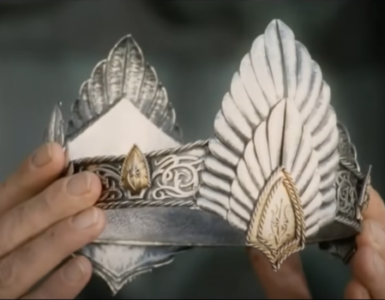When I was sixteen, I got lost on the Chartres Pilgrimage in France. It was raining. I had been separated from my chapter and didn’t know what to do. Squelching through the mud, I heard a young cassocked man speaking English and asked for his help. “Who’s your group?” this seminarian asked. He was friendly. “St. Clement’s, from Ottawa.” “Follow me,” he said—and started to run. I followed. We ran through chapter after chapter, through clusters of countries and communities. We ran through the wet, trampled earth, dodging flag-bearers, the man’s black cassock flapping and splattered with mud. Then, a familiar banner, a familiar face. I was found. He waved and was gone.
Twenty years later, I was lost again. I was the headmaster of a boys’ school with no home and we were on a pilgrimage of sorts to find one. It was raining, and it was Ash Wednesday. Our school had operated for many years at a beautiful property that we had lost the use of, and I had ambitions to regain it. Every year, I wrote a letter of inquiry to the district superior of the priestly order who owned the old building, but to no avail. This year, I thought I would try something different. I decided to call the superior general himself and ask him point blank if he would sell the property to us. Maybe he would help me if I took a bold, direct approach.
As I looked up the priest’s Switzerland number, I saw his picture on my screen. A friendly face. Perhaps it wouldn’t be as pointless as it promised. As I asked my inconceivable question over the phone on that rainy Ash Wednesday, I thought of the face of the man I was appealing. And I suddenly recognized it. It was him—the young seminarian who had helped me in France so long ago. It was him again…
The Lenten Pilgrimage
The ashes smeared on our brows today are a sign of our lost-ness—our descent into dirt and death, and our need to be washed clean and made new again. Lent is a pilgrimage for lost souls, and one where the holy often comes to us instead of us to it. Such experiences are gifts of grace, for they remind us that we are going somewhere spiritually even if we are not going anywhere physically—that we are going back to some invisible mystery from whence we came.
It is wonderful when we have those intimations of return, of coming home, in the unexpected circlings of our own lives, when the invisible becomes suddenly visible. How many things chalked up to coincidence are actually miraculous road signs leading us on to return to our origin? The revolution of things are wheels that are on the move, carrying us as in a chariot to a heavenly home. And we must be watchful for those moments, those little homecomings that point to a larger one.
Lent, like any pilgrimage, is an adventure. As Hilaire Belloc explains in his robust little essay “The Idea of a Pilgrimage,” it is a coming toward (from ad-ventus), a coming into contact with something holy that is, at first, too far to see. It is when we come toward those ordinary things of earth and ash and gain an extraordinary clarity that suddenly transforms our wonders into wisdoms. It is then that our Lenten pilgrimage comes toward something sacred: a shrine, a church, a grave, a home, a family—or Easter Sunday. Belloc says,
On the way I will see all I can of men and things; for anything great and worthy is but an ordinary thing transfigured, and if I am about to venerate a humanity absorbed into the divine, so it behoves me on my journey to it to enter into and delight in the divine which is hidden in everything.
And so are there secrets of divine delight hidden everywhere in everything, and they are waiting for us to unveil like a bride or unearth like a treasure, if only we wait and watch for them to appear on the horizons of our lives—as the spires of Chartres Cathedral do, thin and grey, like a mirage, or a miracle, on the second day of walking. There are meanings to things that emerge from the blue distance once we allow them to approach us over time, which is part of the glorious jest of our redemption.
As G. K. Chesterton said, “It is the test of a good religion whether you can joke about it,” and this is the pilgrim’s vision of the world and of Christianity: that Christians see the joyful juxtapositions of death and resurrection, faith and reason, sense and nonsense, peasant and king, heaven and earth, God and Man. The revolution of such improbable juxtapositions and implausible relations are a great cause for joy and contemplation, especially as they are enshrined in every fellow pilgrim we meet along the way of our Lenten lives.
The reality of the Church is that it is comprised of every type of Chaucerian pilgrim with their particular faults and flaws. In short, the Church is comprised of sinners, not of saints, and we must learn to “to think of people,” as Dickens’s Carol sings, “as if they really were fellow-passengers to the grave, and not another race of creatures bound on other journeys.” The deeper challenge of the Lenten sojourner is to be light on a heavy road, to find joy in the weary way. It is the balance between taking nothing seriously and taking everything seriously, and the balance is a Catholic one. Catholics need to march the line between being too intense and too indifferent, for the Faith is neither severe nor senseless. It is joyful, and joy is a quality requiring both seriousness and lightheartedness.
Again, from Belloc’s vision of a pilgrim,
I would rather for the moment that he went off in a gay, tramping spirit, not oversure of his expenses, not very careful of all he said or did, but illuminated and increasingly informed by the great object of his voyage… to loose the mind and purge it in the ultimate contemplation of something divine.
Pilgrims Seeking Resurrection
It is strange and wonderful how God intersects the paths of His creatures to help them find themselves and find Him along the wild ways of our lives. One Ash Wednesday, I needed help and I suddenly found one who had helped me before. And he helped me again. Our school returned to its old home soon after that phone call. It goes to show that we must be a little lost before we can find those signs of affirmation that Our Lord uses to lead us on, to draw us to an ever-increasing belonging, to hearken us home. And we need to be attentive to the Lord’s refrains along our pilgrimage—especially our Lenten pilgrimage—and to be up for the adventure of finding them.
We all plant perennials in the soul that may only be noticed and appreciated after years of blooming, even as Mary kept all those things and pondered them in her heart. It is in those moments of unexpected comprehension that the salvation of a soul may well lie. Such are the Lenten homecomings of a true pilgrimage. As pilgrims seeking the Resurrection, we must seek the way, the truth, and the life in ordinary dusty things, and Lent is the time to do it, until we rejoice to find that they are coming toward us even as we come toward them. Ash up, pilgrim!
✠
Photo by Grant Whitty on Unsplash












